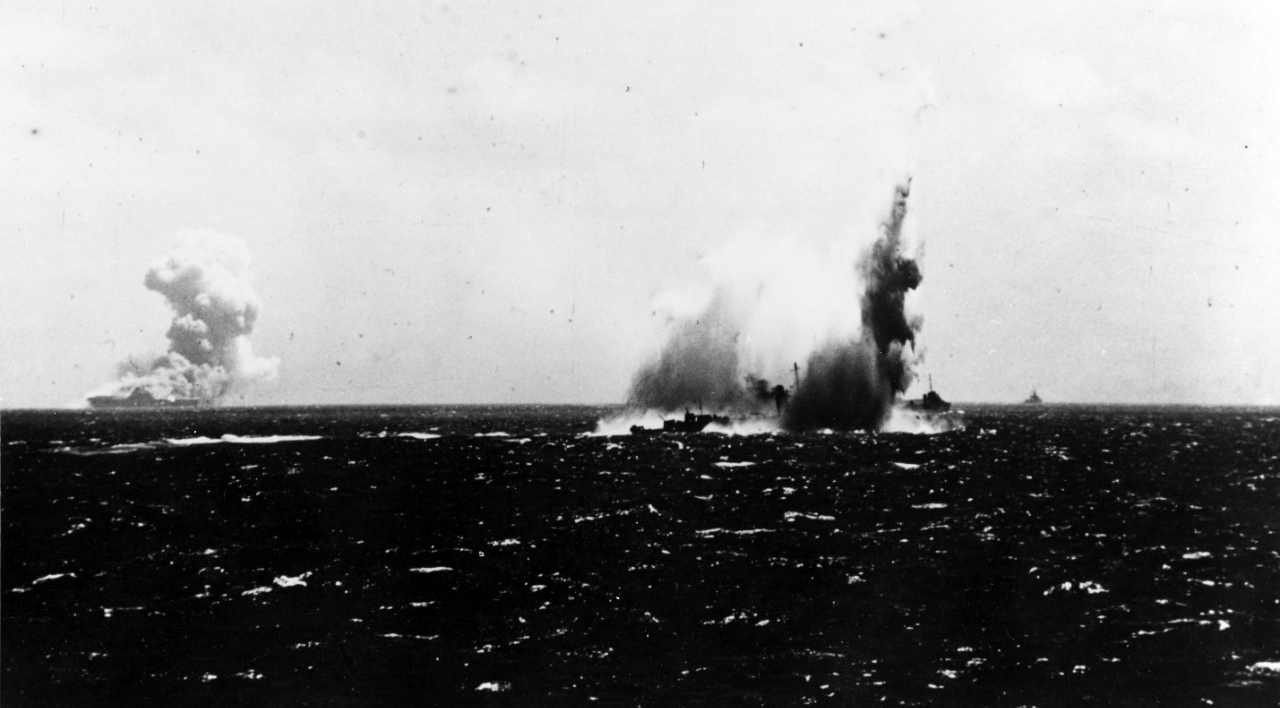Status - John Skinner - USS O'Brien:
Hornet and Wasp were now protecting the convoy that was to bring the new Marine regiment to Guadalcanal. The two carriers were separated by about 5 miles, and were in the Coral Sea, about 150 miles southeast of San Cristobal Island, which was at the southeast end of the Solomons chain. They were maintaining a position between Japanese forces and the convoy, and had planes in the air constantly. Wasp had the day's duty for the combat air and anti-submarine patrols.
Several spots in the oceans had been nicknamed "Torpedo Junction" (no doubt sardonically named after the Glenn Miller Orchestra's Tuxedo Junction, a #1 hit song in 1940). The two carriers were right in the middle of one of these. Japanese submarines were always present here, and with the convoy in the area, were even more alert.
Wasp was maneuvering to recover planes, and inadvertently lined itself up for a shot from Japanese submarine I-19. The Japanese sub took full advantage, firing a spread of 6 torpedoes at the carrier. Three impacted Wasp and started a series of huge explosion on the carrier. Sailors on the O'Brien would have seen the explosions immediately, but would have already begun to change their ship's course in reaction before they heard the report of the blasts some half a minute later.
The three torpedoes that missed Wasp continued on with their remaining fuel. One of these was dodged by destroyer Mustin but scored a direct hit on battleship North Carolina. The other two were heading straight for the USS O'Brien.
O'Brien's crew had seen the first torpedo, and had swerved to starboard, successfully avoiding the it as it passed a small distance from the stern. The second torpedo, however, had gone unnoticed; by the time it was seen it was to late to avoid, and crashed into O'Brien's bow. The moment of impact was captured in one of the more famous photos of World War 2 (below):
Wasp burns in the background as torpedo strikes O'Brien:

The torpedo had severely damaged the bow on the O'Brien and shaken the ship violently, but there were no casualties. Even with the damage, the ship could still make 15 knots, and was ordered to head unescorted to Espiritu Santo (BUTTON) for repairs, reaching there on the 16th. O'Brien went alongside repair ship USS Curtis.
Wasp continued to burn and could not be salvaged. It was sunk with torpedoes from destroyer Lansdowne. Hornet took on Wasp's planes that were still airborne, and was now the only US carrier in the South Pacific. The Wasp's sinking was held secret until December; only then could sailors on leave talk about the loss of Wasp.
North Carolina returned to Pearl Harbor for repairs. Fast Battleship strength was down from three to one as a result (South Dakota having earlier scraped a reef and retired to Pearl Harbor).
This single spread of torpedoes was the most devastating of the war; it had initially been credited to two Japanese submarines, but in reality came only from I-19.
The convoy carrying the Marines, despite losing much of its air cover, did land on Guadalcanal on the 18th, bringing much needed relief to the garrison there.
U. S. Navy Task Forces:
- Task Force
16 (Enterprise) was at Pearl Harbor, for repairs to Enterprise.
- Saratoga was also returning to Pearl Harbor for repairs. Arrives Sep. 21.
- Combined
Task Force 61 remained on patrol in the Coral Sea near Guadalcanal.
- Task Force 17 (Hornet) -> TF 61
- Wasp was sunk by Japanese submarine I-19 on September 15th.
More Information:
- Official Navy Chronology, pp. 252-253.
- The First Team and the Guadalcanal Campaign, John B. Lundstrom, pp 221-229.
- The Struggle for Guadalcanal, Samuel Eliot Morison, pp. 130-138.
- Neptune's Inferno, The U.S. Navy at Guadalcanal, James D. Hornfischer, pp. 118-131.
NEXT POST: SEPTEMBER 22ND
No comments:
Post a Comment